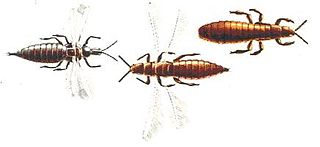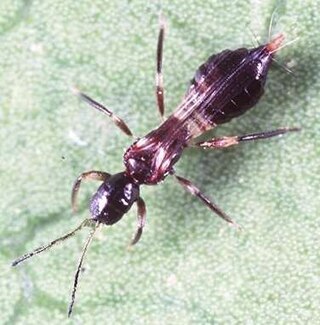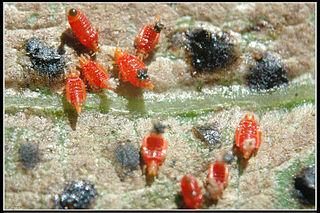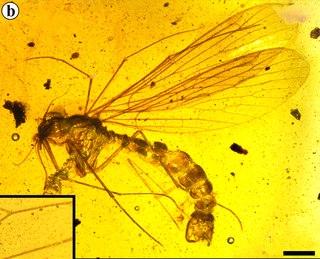
Thrips are minute, slender insects with fringed wings and unique asymmetrical mouthparts. Entomologists have described approximately 7,700 species. They fly only weakly and their feathery wings are unsuitable for conventional flight; instead, thrips exploit an unusual mechanism, clap and fling, to create lift using an unsteady circulation pattern with transient vortices near the wings.
The Cenomanian is, in the ICS' geological timescale, the oldest or earliest age of the Late Cretaceous Epoch or the lowest stage of the Upper Cretaceous Series. An age is a unit of geochronology; it is a unit of time; the stage is a unit in the stratigraphic column deposited during the corresponding age. Both age and stage bear the same name.
Michael S. Engel, FLS, FRES is an American paleontologist and entomologist, notable for contributions to insect evolutionary biology and classification. In connection with his studies he has undertaken field expeditions in Central Asia, Asia Minor, the Levant, Arabia, eastern Africa, the high Arctic, and South and North America, and has published more than 925 papers in scientific journals and over 1000 new living and fossil species. Some of Engel's research images were included in exhibitions on the aesthetic value of scientific imagery.

Pelecinidae is a family of parasitic wasps in the superfamily Proctotrupoidea. It contains only one living genus, Pelecinus, with three species known from the Americas. The earliest fossil species are known from the Jurassic, and the group was highly diverse during the Cretaceous. Members of Pelecinus are parasitic on larval beetles, flies, green lacewings, and sawflies.

The Berothidae are a family of winged insects of the order Neuroptera. They are known commonly as the beaded lacewings. The family was first named by Anton Handlirsch in 1906. The family consists of 24 genera and 110 living species distributed discontinuously worldwide, mostly in tropical and subtropical regions. Numerous extinct species have also been described. Their ecology is poorly known, but in the species where larval stages have been documented, the larvae are predators of termites.

The Ommatidae are a family of beetles in the suborder Archostemata. The Ommatidae are considered the extant beetle family that has most ancestral characteristics. There are only seven extant species, confined to Australia and South America. However, the geographical distribution was much wider during the Mesozoic spanning across Eurasia and Australia, suggesting that they were widespread on Pangea. So far, over 26 extinct genera containing over 170 species of these beetles have been described. Three extant genera have been assigned to this family: Omma,Tetraphalerus and Beutelius. The family is considered to be a subfamily of Cupedidae by some authors, but have been found to be more closely related to Micromalthidae in molecular phylogenies. A close relationship with Micromalthidae is supported by several morphological characters, including those of the mandibles and male genitalia. Due to their rarity, their ecology is obscure, it is likely that their larvae feed on deadwood.

Terebrantia is a suborder of thrips. Order Thysanoptera includes 5,500 species classified into two suborders distinguished by the ovipositor. Terebrantia have a well-developed conical ovipositor, while the Tubulifera do not. It contains 13 families, five of which are only known from fossils. Members of Terebrantia mainly feed on plants. All have two larval instars followed by two pupal instars.

Panchaetothripinae is a subfamily of thrips in the family Thripidae, first described in 1912 by Richard Siddoway Bagnall. There are about 11 genera and more than 50 described species in Panchaetothripinae.
Merothripidae is a family of thrips in the order Thysanoptera. There are at least 4 genera and 20 described species in Merothripidae.
Heterothripidae is a family of thrips in the order Thysanoptera. There are about 6 genera and at least 70 described species in Heterothripidae.
2019 in paleoentomology is a list of new fossil insect taxa that were described during the year 2019, as well as other significant discoveries and events related to paleoentomology that were scheduled to occur during the year.
2020 in paleoentomology is a list of new fossil insect taxa that were described during the year 2020, as well as other significant discoveries and events related to paleoentomology that were scheduled to occur during the year.
Burmese amber is fossil resin dating to the early Late Cretaceous Cenomanian age recovered from deposits in the Hukawng Valley of northern Myanmar. It is known for being one of the most diverse Cretaceous age amber paleobiotas, containing rich arthropod fossils, along with uncommon vertebrate fossils and even rare marine inclusions. A mostly complete list of all taxa described up until 2018 can be found in Ross 2018; its supplement Ross 2019b covers most of 2019.

Pseudopolycentropodidae is an extinct family of scorpionflies known from the Mesozoic. Fossils are known from the Middle Triassic (Anisian) to the early Late Cretaceous (Cenomanian). It is part of Mesopsychoidea, a group of scorpionflies with siphonate proboscis. They are suggested to have been nectarivores, feeding off the liquid pollination drops and acting as pollinators for now extinct insect pollinated gymnosperms such as Bennettitales.

Mimarachnidae is an extinct family of planthoppers known from the Cretaceous period. Their name is derived from spots on the wings of the first described genera, Mimarachne and Saltissus, being suggestive of spider mimicry, but these characters are not distinctive for the family as a whole. The family is characterised by "simplified venation and setigerous metatibial pecten and hind leg armature". as well as "rounded anterior margin of pronotum, double carination of pronotum and mesonotum"

Lagonomegopidae is an extinct family of spiders known from the Cretaceous period. Members of the family are distinguished by a large pair of eyes, positioned on the anterolateral flanks of the carapace, with the rest of the eyes being small. They have generally been considered members of Palpimanoidea, but this has recently been questioned. Members of the family are known from the late Early Cretaceous (Albian) to near the end of the Late Cretaceous (Campanian) of Eurasia, North America and the Middle East, which was then attached to Africa as part of Gondwana. They are generally assumed to have been free living hunters as opposed to web builders.
Melanthripidae is a family of thrips belonging to the order Thysanoptera. Members of the family, covered with gymnosperm pollen, were found in Cretaceous Spanish amber about 110-105 million years old. They are believed to have been pollinators of the Ginkgoales.
This paleoentomology list records new fossil insect taxa that are to be described during the year 2022, as well as notes other significant paleoentomology discoveries and events which occurred during that year.
Hispanothrips is an extinct genus of thrips in the family Stenurothripidae.
This list of 2024 in paleoentomology records new fossil insect taxa that are to be described during the year, as well as documents significant paleoentomology discoveries and events which occurred during that year.









